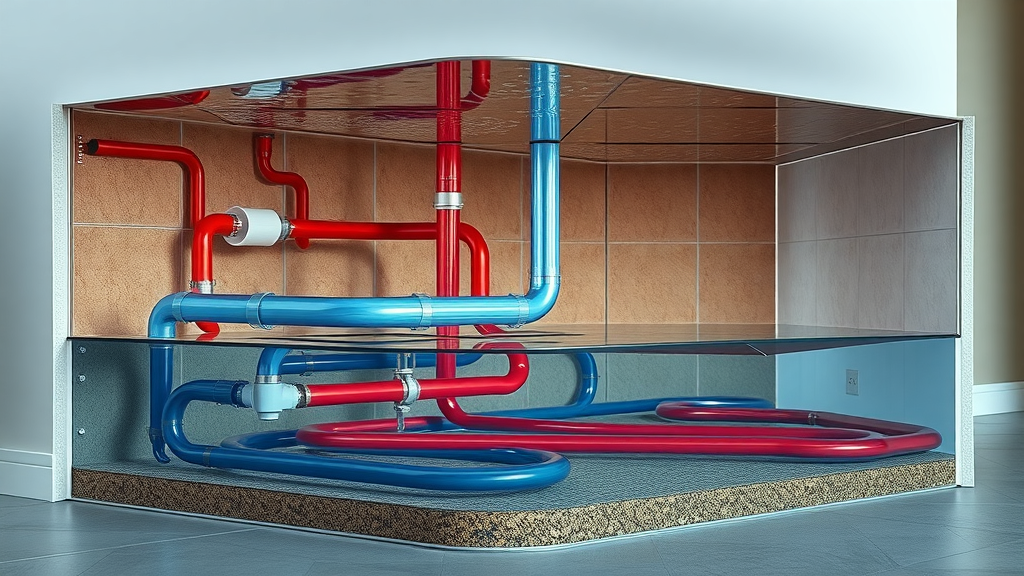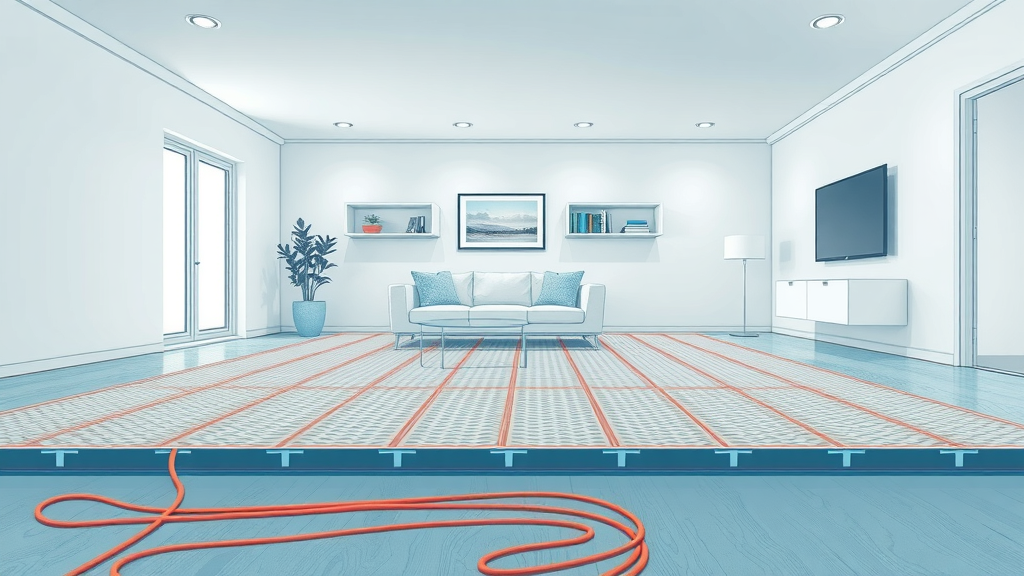Did you know that homes with wet (water-based) underfloor heating systems can cut energy bills by up to 25% compared to traditional radiators? This smart, invisible heating solution is rapidly gaining popularity with homeowners, renovators, and self-builders alike. Imagine walking barefoot in winter on a warm floor—no more cold spots or bulky radiators cluttering your walls. In this article, you'll discover exactly how these water-based systems work, why they make financial and lifestyle sense, and what you need to consider before investing. Read on to uncover whether water underfloor heating is the right choice for your property—and why Peak Underfloor Heating Ltd is the leading expert trusted by UK families.
Startling Insights: Why Wet (Water-Based) Underfloor Heating Systems Are Making Waves
Interest in wet (water-based) underfloor heating systems has exploded in recent years. As modern homeowners seek better comfort, energy savings, and seamless room designs, floor heating has become a top upgrade for both new builds and major renovations. Recent data reveals that demand for water-based underfloor heating systems has doubled in the last five years across the UK. Unlike electric systems, which can be costly to run, these wet underfloor systems deliver warm water through hidden pipework, creating a cosier, more energy-efficient space throughout every season.
The core attraction? Consistent, gentle warmth across every corner of your home, eliminating cold spots and freeing up valuable wall space by removing the need for radiators. These heating systems aren’t just for luxury bathrooms—families are installing them in kitchens, lounges, and even bedrooms to boost everyday comfort and reduce carbon footprints. In a world increasingly focused on energy efficiency and sustainability, investing in a modern underfloor heating system is a future-proof choice for your property.

- What You’ll Learn About Wet (Water-Based) Underfloor Heating Systems
- How water-based underfloor heating provides whole-home comfort and energy savings
- Practical pros and cons—see if it best fits your new build or renovation
- Installation steps and what to watch out for
- Who should install: why choosing the right expert matters
- Cost insights: upfront and ongoing running costs explained
- Common FAQs and advice directly from industry leaders
Understanding Wet (Water-Based) Underfloor Heating Systems
To make an informed choice, it’s vital to truly understand how wet (water-based) underfloor heating systems operate. Unlike electric floor heating, these systems use a network of pipes beneath your floor to circulate warm water, turning your entire floor into a vast, gentle radiator. It’s a system that can be seamlessly integrated into new builds or added to renovation projects with expert planning. When combined with renewable heat pumps or a modern boiler, wet underfloor heating offers greater efficiency compared to traditional radiators. Let’s break down what makes this heating solution unique and why it outperforms electric alternatives in many homes.
What Is a Wet Underfloor Heating System?
A wet underfloor heating system—sometimes called a water underfloor heating system—uses a web of durable plastic pipes installed beneath the floor surface. Warm water flows through these pipes, evenly heating the entire surface area of your room. Unlike wall-mounted radiators that create hotspots and cold corners, wet underfloor heating gives consistent warmth from the ground up. The system is typically connected to a heat source like a gas boiler, an air source heat pump, or even solar panels, making it flexible and compatible with the latest renewable energy trends. For new builds or significant renovations where the floor will be lifted, a wet underfloor heating kit is often the go-to solution for whole-home comfort and future energy savings.
How Wet (Water-Based) Underfloor Heating Systems Work
Wet underfloor heating works through a straightforward yet highly effective principle: distributing warm water beneath the floor surface. A manifold—a special control centre—is connected to your heat source and manages the flow of hot water into a series of flexible pipes embedded in the subfloor. As warm water circulates, it radiates steady heat upwards, creating a comfortable, even temperature throughout the room. The system is typically zoned, so you can control different areas separately for optimal efficiency. Whether paired with a high-efficiency condensing boiler or an air source heat pump, this design means you get maximum warmth with minimal wasted energy. If you’re after superior comfort and improved energy consumption, few options match the performance of a modern wet underfloor heating system.

Comparing Wet Underfloor Heating to Electric Alternatives
Electric underfloor heating systems use electrical mats or cables to heat floors, making them well-suited to smaller spaces or quick retrofits. However, wet underfloor heating systems have a number of advantages—especially in whole-home applications or energy-conscious builds. Firstly, water underfloor heating distributes heat more evenly and efficiently, thanks to the larger mass of warm water compared to wire mats. It also works best with renewable heat sources like air source heat pumps or ground source heat pumps, which electricity-powered systems sometimes struggle to match for cost-effectiveness in larger or frequently used rooms. If you’re weighing both solutions, remember: electric can be convenient for single rooms or occasional use, but wet underfloor heating offers lower running costs, increased comfort, and better synergy with the latest eco-friendly heating trends—making it the natural choice for serious home upgrades, new builds, or whole-house renovations.
Key Benefits of Wet (Water-Based) Underfloor Heating Systems
Homeowners and property experts alike are turning to water underfloor heating systems for their powerful blend of comfort, efficiency, and property value. These systems deliver a broad array of benefits that go far beyond just removing the need for radiators. Wondering if it’s the smartest heating system for your next project? Let’s unpack the key advantages you’ll enjoy from this modern solution.
Whole-Home Comfort: Even Heat Distribution Across Your Floor
With wet underfloor heating, every inch of your floor radiates warmth, erasing those familiar cold spots near windows and doors. The secret is in the large surface area: by using your entire floor, the heating system can operate at lower temperatures, maintaining a stable, pleasant environment. This is particularly noticeable during the winter months, when traditional radiators often struggle to heat large or irregularly shaped spaces evenly. Families with open-plan living areas, extensions, or rooms with lots of glazing particularly praise the system for its ability to keep comfort levels high throughout every corner, not just near a heat source. The gentle radiant heat boosts overall wellbeing, making your home a sanctuary in any weather.
Energy Efficiency & Savings with Modern Heating Systems
Since wet underfloor heating systems use lower water temperatures than radiator-based central heating, they’re inherently more energy efficient. When combined with state-of-the-art heat pumps or efficient gas boilers, these systems become the backbone of a sustainable home. The result? Substantial energy savings—not just in theory, but in real-life cases where energy bills have decreased by a quarter or more. Plus, modern thermostatic controls allow for precise, zoned management of different spaces, ensuring you only use energy where and when it’s needed. If your aim is long-term savings, reduced carbon emissions, and future-proofing for evolving energy standards, wet underfloor heating is a smart, responsible choice.
Improved Air Quality and Allergen Reduction
One often-overlooked advantage is the improvement to your home’s air quality. Traditional radiators cause air to circulate and stir up dust and allergens as they heat, which can worsen conditions like hay fever or asthma. Wet underfloor heating avoids this problem by delivering slow, radiant warmth from below, minimising air movement and keeping dust down. The result is an environment that feels fresher, more comfortable, and healthier for sensitive family members, children, or pets. Say goodbye to stuffy rooms—your living space will be cleaner and easier to breathe in year-round.

Compatibility with Renewable Heat Pumps and Warm Water Sources
Wet underfloor heating systems shine when paired with renewable technologies. Air source or ground source heat pumps work especially well, supplying warm water at the lower temperatures water underfloor heating demands. This synergy boosts system efficiency and further reduces operating costs. Homeowners seeking to maximise sustainability or who want to take advantage of government incentives for clean energy often find water-based underfloor heating an ideal match. Whether you’re future-proofing a new build, adding renewables to a retrofit, or connecting to a modern combi boiler, wet underfloor heating adapts perfectly to today’s energy landscape.
Increased Property Value with Underfloor Heating Systems
A modern, efficient heating system is a major selling point that can significantly raise your property’s value. Underfloor heating not only adds a touch of luxury but also signals to buyers that your home is up to date, energy-smart, and ready for the future. Gone are unsightly radiators—open wall space is back, and every room becomes more flexible for decor and furniture placement. This can be the detail that makes your property stand out to discerning buyers, especially in highly competitive markets for new builds or renovated homes.
"When we installed our water underfloor heating, energy bills dropped by 25%. This system paid for itself in just a few years." – Homeowner, Derbyshire
Drawbacks and Considerations of Wet Underfloor Heating Systems
Yet, no heating system is without its trade-offs. While wet underfloor heating offers compelling advantages, there are important considerations to weigh—especially for those retrofitting older homes or working with a tight budget. Here’s what you need to know before taking the plunge, helping you avoid potential pitfalls and make the right decision for your project.
Initial Investment and Installation Complexity
The biggest hurdle for many homeowners is the upfront investment. Wet underfloor heating typically costs more to install than electric systems, due in part to the labour and materials involved (pipework, manifolds, insulation, and screed). The installation must be carefully designed and executed to avoid leaks or inefficiencies—this is where working with an experienced specialist is essential. While the higher initial outlay is offset by lower running costs over time, it’s wise to budget appropriately and plan installation phases, especially as part of a full renovation or new build project.
Suitability for Retrofits vs. New Builds
Wet underfloor heating is best suited to new builds or major renovations, where new floors are being laid anyway and there’s scope to integrate pipework and insulation seamlessly. Retrofitting into existing homes is possible but can be invasive and disruptive, as existing floors may need to be lifted or replaced. However, experienced professionals can often design systems that minimise hassle, especially if you’re already planning significant upgrades. Still, homeowners should be realistic about timescales, costs, and which rooms will benefit the most from the investment.

Response Times and Heat Up Speeds
Unlike electric systems, which heat up rapidly, wet underfloor heating takes longer to “come on” because it warms the mass of the floor itself. This slower response is not typically a problem in well-insulated, modern homes—but if you’re seeking instant heat (for example, in a small bathroom on a cold morning), it’s something to be aware of. Smart thermostats and zoning can mitigate this by pre-heating rooms before use, combining efficiency with comfort for busy households.
Long-Term Maintenance and Lifespan
Wet underfloor heating systems are long-lasting, with many installations operating trouble-free for decades. However, like any complex heating system, occasional maintenance is needed—especially to check for leaks, ensure the manifold is working smoothly, and flush out system sludge. Choosing quality components and expert installation helps to minimise ongoing issues. Leading companies such as Peak Underfloor Heating Ltd offer maintenance contracts to keep your investment running efficiently and extend its lifespan even further.

Space Planning and Floor Build-Up Considerations
Wet underfloor heating requires space for pipework and insulation beneath your floor. This means a slightly higher floor level—or ‘build-up’—compared to electric mats or existing radiator systems. In new builds or full refurbs, this can be designed in from the start. In retrofits, careful planning is essential to ensure door clearances, floor finishes, and step heights remain practical. While most homes can accommodate the extra depth, it’s wise to discuss your options with a specialist during the planning stage.
"Wet underfloor heating is best considered at the design phase, but with expert installation it can also enhance existing homes." – Peak Underfloor Heating Ltd Engineer
| Feature | Wet (Water-Based) Underfloor Heating | Electric Underfloor Heating |
|---|---|---|
| Best Use Case | Whole-home, new builds, major renovations | Single rooms, retrofits, bathrooms |
| Installation Cost | Higher upfront, lower running costs | Lower upfront, higher running costs in large spaces |
| Energy Efficiency | Very efficient with heat pump or condensing boiler | Less efficient, especially in larger areas |
| Heating Response Time | Slower heat-up/cool-down – ideal for continuous use | Fast heat-up/cool-down – best for short-term use |
| Integration with Renewables | Excellent (works with air/ground source heat pumps) | Limited |
| Lifespan & Maintenance | Long-lasting, occasional flushing and checks | Minimal maintenance, shorter lifespan in some cases |
Suitability: Who Should Choose Water Underfloor Heating Systems?
- Best Fit Properties: Wet underfloor heating is perfect for new builds, extensions, or major renovations where the floors are being rebuilt. It can also suit open-plan homes, large ground-floor spaces, and properties planning to use renewable heat pumps or install future-forward technology.
- If you own a period property or are undertaking a full retrofit—consult an expert first. With careful planning and the right installation team, even older homes can benefit from water underfloor heating’s comfort and efficiency gains.
- When to Prioritise Wet Underfloor Heating: Choose water underfloor heating when you want even heat, lower running costs, and compatibility with modern heating solutions.
- It’s also the preferred option when maximizing property value and creating a comfortable, healthy living space is a top priority—especially for families who plan to enjoy their home for many years to come.
How Much Does a Wet Underfloor Heating System Cost?
The cost of a wet underfloor heating system is an important consideration for most homeowners. Several factors contribute to the final price tag, including the size and complexity of your project, the heat source selected, and the quality of installation. Here’s what you need to know about upfront investment, ongoing savings, and making the most of your budget.
Typical Upfront Pricing for Water Underfloor Heating
On average, expect to pay between £70–£110 per square metre for supply and professional installation in the UK. Large open spaces will benefit from economies of scale, whereas smaller or more intricate layouts may increase costs somewhat. For a typical 80 m² ground floor of a new build or renovation, your budget should be in the range of £6,000–£9,500 to cover pipes, insulation, manifold, controls, and professional fitting. Investing in a high-quality heating system pays dividends in comfort, resale value, and peace of mind.
Running Costs and Long-Term Energy Savings
The appeal of wet underfloor heating grows over time thanks to its energy-saving profile. Operating costs can be up to 25% less than conventional radiators, especially when paired with a modern condensing boiler, air source heat pump, or other renewable technologies. Lower water temperatures mean less energy input and less strain on your heating system. Maintenance costs are generally low; simple annual checks and occasional flushing will keep the system working perfectly for decades. Over 15–20 years, savings can add up, making wet underfloor heating a truly cost-effective choice in the long run.
Cost Factors: Installation, Heat Supply Options, and Maintenance
Installation costs are influenced by your choice of floor heating kit, the type of heat source (e.g., gas boiler vs. heat pump), floor finish, and system controls. It’s worth investing in knowledgeable installers—such as Peak Underfloor Heating Ltd—to avoid issues and ensure the best possible performance. Don’t forget to factor in government grants or incentives for renewable heating, which can make a significant dent in upfront costs. Discuss a tailored estimate with a qualified provider for a comprehensive breakdown.
Step-by-Step: How to Install Wet Underfloor Heating Systems
- Project design and heat loss calculations: Experts assess the right pipe layout, insulation, and flow rates for your space.
- Prepare the subfloor and install insulation: Ensuring minimal heat loss and peak performance.
- Laying pipes according to the plan: Pipework is clipped in place following room-by-room specifications.
- Connecting the manifold and controls: Integrating the system with your heat supply.
- Pressure testing for leaks: Ensuring all joints and pipes are sound.
- Applying screed or dry levelling boards: Encasing the pipes and preparing for your chosen floor finish.
- System commissioning: Bleeding air, initial heating, and running final checks for optimum performance.
Choosing the Right Installer for Your Underfloor Heating System
Choosing the right installer could make all the difference between years of trouble-free comfort and costly repairs. Wet underfloor heating requires technical expertise for design, installation, and commissioning. Trusting a proven specialist like Peak Underfloor Heating Ltd guarantees not only a hassle-free process but also optimal system performance. Expert advice is available from the start, guiding you through product selection, layout, and every detail of the underfloor heating system—including aftercare and support.
Why Select Peak Underfloor Heating Ltd for Your Project?
Peak Underfloor Heating Ltd stands out for their technical know-how, exceptional service, and unwavering commitment to customer satisfaction. Their experience covers every project scale, from single-room upgrades to entire new-build developments—ensuring robust solutions for even the trickiest scenarios. With transparent pricing, in-depth planning, and a wealth of five-star reviews from happy homeowners, they are the reliable partner who will see your project through from design to warm, welcoming finish.
Credentials, Experience, and Client Reviews
The best way to gauge your installation partner is through real client experiences. Peak Underfloor Heating Ltd’s engineers are fully trained and certified for all major system types, including renewable energy integration such as heat pumps. Glowing testimonials highlight responsive communication, attention to detail, and systems that reliably outperform expectations. For independent proof, ask to see recent installation photos, detailed project breakdowns, or request direct references. When only the best will do for your home, this is the gold standard in UK underfloor heating.
People Also Ask
[[paa]]
Answers to Popular Water Underfloor Heating Questions
Is wet underfloor heating suitable for all floor types? Yes—water underfloor heating works with tiles, wood, stone, and even carpet. However, it’s important to match the right insulation and ensure flooring is compatible with radiant heating. An expert can help select finishes that deliver maximum efficiency and comfort.
Can wet underfloor heating be used with heat pumps? Absolutely. Pairing with air source or ground source heat pumps is ideal, as both operate efficiently at low water temperatures—cutting energy bills while delivering excellent whole-home heat.
Does underfloor heating need a lot of maintenance? No, water underfloor heating systems are low-maintenance. Periodic servicing, including checking the manifold and occasional system flushing, keeps everything running smoothly. High-quality installation further minimises the risk of leaks or faults.
Frequently Asked Questions About Wet (Water-Based) Underfloor Heating Systems
- How does wet (water-based) underfloor heating compare to electric? – Water-based systems are more cost-effective for large areas, while electric mats suit small or single rooms.
- Can I retrofit wet underfloor heating into my old house? – Yes, but expect some floor disruption. A specialist can recommend the best system for your property type.
- Are there grants or incentives for installing efficient underfloor heating systems? – Many schemes for renewable energy include support—ask your installer for advice on the latest options.
- What’s the lifespan of a wet underfloor heating system? – With proper care, 30+ years is standard—pipes are designed for decades of worry-free comfort.
- Who should I trust for installation? – Choose experienced teams like Peak Underfloor Heating Ltd, with proven technical credentials and positive client feedback.
Key Takeaways – Wet (Water-Based) Underfloor Heating Systems
- Pros: Even, comfortable heat; lower running costs; improved air quality; compatible with renewables; adds property value.
- Cons: Higher upfront cost; slower to heat up than electric systems; best suited to new builds or major renovations; careful floor planning needed.
- Cost and Comfort: While initial investment can be significant, energy and comfort savings quickly add up—especially in whole-home applications.
- Who Should Install: Anyone upgrading a family home, building new, or seeking a modern, energy-efficient lifestyle. For best results, always hire a reputable specialist installer.
Conclusion: Is a Wet (Water-Based) Underfloor Heating System Right for You?

If you want lasting comfort, lower energy bills, and a healthier home, wet (water-based) underfloor heating is the upgrade to choose. For the smoothest journey—from design to daily use—trust the specialists at Peak Underfloor Heating Ltd.
Ready to Transform Your Home? Contact Peak Underfloor Heating Ltd Today!
Start your journey towards a warmer, smarter, happier home. Contact us for a free, expert assessment. Discover how Peak Underfloor Heating Ltd can design, supply, and fit the perfect heating system for your unique project. Your dream comfort is just a step away.
Sources
- Energy Saving Trust – https://www.energysavingtrust.org.uk/advice/underfloor-heating/
- Renewable Energy Hub – https://www.renewableenergyhub.co.uk/main/underfloor-heating-information/
- Peak Underfloor Heating Ltd – https://www.peakunderfloorheating.co.uk/
Wet (water-based) underfloor heating systems offer numerous advantages, including consistent heat distribution, energy efficiency, and space-saving design. For a comprehensive understanding of these benefits, consider reading “Considering underfloor heating? How to choose the right system for your project”, which provides detailed insights into system types and their suitability for various projects. Additionally, “The Advantages of Installing Wet Underfloor Heating” delves into the energy efficiency and comfort enhancements these systems bring to modern homes. If you’re serious about upgrading your heating system, these resources will give you the knowledge needed to make an informed decision.
 Add Row
Add Row  Add
Add 









Write A Comment